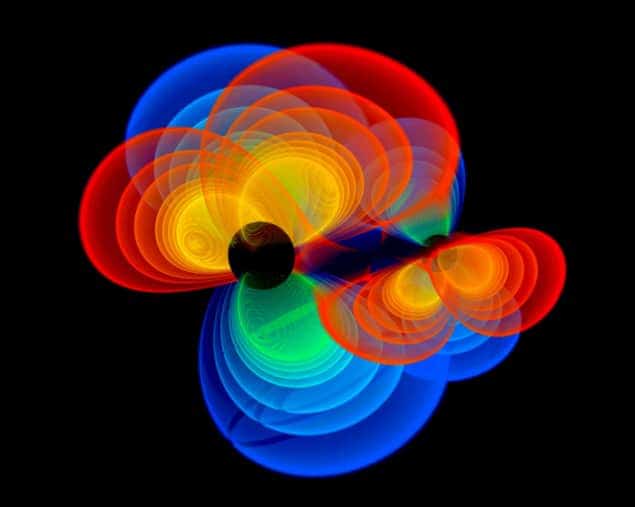
Astronomers have been left scratching their heads after an international team failed to find evidence for gravitational waves in 11 years’ worth of radio-telescope observations. The team had expected to see a modulation in the arrival time of pulsar signals caused by gravitational waves from binary supermassive black holes (SMBHs). The null result could mean that binary SMBHs collapse much faster than previously thought, and therefore spend much less time broadcasting gravitational waves. The result could also provide important information to astrophysicists who are trying to model binary SMBHs.
SMBHs have masses in excess of one million Suns and exist at the cores of many galaxies. When galaxies collide, their two SMBHs will form a rotating binary system that will eventually merge into one SMBH. As the two SMBHs get closer together, their gravitational potential energy is broadcast outwards in the form of gravitational waves. These waves are ripples in space–time that are predicted by Einstein’s general theory of relativity but have yet to be detected by astronomers.
Cosmic timekeepers
One proposal for detecting gravitational waves is to measure their effect on the signals we receive from millisecond pulsars. These cosmic timekeepers emit pulses of radio waves at extremely stable frequencies – some even rivalling the stability of an atomic clock. If the signal from a pulsar happens to travel through a binary-SMBH gravitational wave on its way to Earth, then the distance travelled by some of its pulses will be stretched or compressed by about 10 m. While this is a tiny distance compared with the overall journey, it should be revealed by tiny changes in the relative arrival times of several successive pulses.
The sensitivity of such a measurement is increased if a number of pulsars are monitored to create a pulsar-timing array. One such project is the Parkes Pulsar Timing Array, which is running at the Parkes Observatory in Australia. Now, astronomers working on the array have released the latest results in their attempt to measure something called the gravitational-wave background (GWB). This is a mishmash of gravitational waves generated by all of the binary SMBHs in the universe, and is described by the team as a “background rumble”.
Billionths of a second
The team focused on four pulsars that are known to have very high timing precisions, and are therefore best suited to reveal the GWB. Over an 11 year period, the team recorded the arrival times of the pulses to an accuracy of 10-billionths of a second – which is the time it takes for radio waves to travel about 3 cm.
We heard nothing. Not even a whimper
Ryan Shannon, Parkes Observatory
“But we heard nothing. Not even a whimper,” says team member Ryan Shannon of the Parkes Observatory. “It seems to be all quiet on the cosmic front – at least for the kind of waves that we are looking for.”
Now, astronomers and astrophysicists are left wondering why no sign of the GWB was seen. One possibility, according to the team, is that SMBHs merge much more quickly than expected. As a result, the binaries would spend less time generating gravitational waves. Team member Paul Lasky of Monash University speculates how this could happen: “There could be gas surrounding the black holes that creates friction and carries away their energy, allowing them to come to the clinch quite quickly.”
The null result means that the Parkes team will have to keep looking for many more years before it can hope to see evidence of the GWB. However, future telescopes such as the Square Kilometre Array – which will come online in 2020 – may have better luck.
Better models
Ben Stappers of the University of Manchester in the UK describes the latest work from Parkes as “an exciting result”. He told physicsworld.com that astronomers working on other pulsar-timing-array programmes such as the European Pulsar Timing Array and the North America Nanohertz Observatory for Gravitational Waves will now be looking at their newest data to see if they are able to confirm the result. Stappers also points out that the Parkes measurement provides important information to astrophysicists who are developing models of how SMBHs merge.
Parkes team member Vikram Ravi of the Californai Institute of Technology points out that the failure to detect the GWB has no implications on experiments such as Advanced LIGO, which are looking for gravitational waves from sources other than binary SMBHs.
The observations are described in Science.
- There is much more about pulsar timing arrays in this award-winning article by Physics World‘s Louise Mayor: “Hunting gravitational waves using pulsars”.



